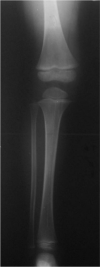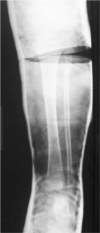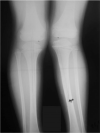Does Cozen's phenomenon warrant surgical intervention?
- PMID: 32582389
- PMCID: PMC7302407
- DOI: 10.1302/1863-2548.14.190147
Does Cozen's phenomenon warrant surgical intervention?
Abstract
Purpose: Proximal tibial metaphyseal fractures can be complicated by a late valgus deformity, referred to as Cozen's phenomenon. We studied children with such fractures to determine whether the child's age at the time of injury influenced the development of Cozen's as well as the occurrence of elongation. In addition, we explored whether the deformity resolved at long-term follow-up.
Methods: We conducted a retrospective study of 33 patients (six months to 14 years old). Mean follow-up was 8.8 years (3 to 25). We measured angulation of the fractured limb post-treatment, at maximum deformity and final follow-up, as well as elongation and compared them with the uninjured limb.
Results: Three of the fractures were treated surgically whereas the rest, nonoperatively. In all, 15 out of 33 fractures developed late valgus deformity between eight and 19 months (mean time 12.5 months). A total of 24 fractures developed elongation. We found no association of either of these with age. Angulation increased to a statistically significant level, from post-treatment to maximum deformity, and then decreased at final follow-up, leaving no statistically significant difference from the initial measurement. The difference in valgus between fractured and uninjured limb increased to a statistically significant level from post-treatment to maximum deformity and then decreased, leaving an excess from the initial measurement.
Conclusion: In almost half the patients, late valgus deformity developed within two years post-fracture and corrected to the initial post-treatment angles. Patients should be warned of this possibility and reassured of its natural resolution.
Level of evidence: IV.
Keywords: Cozen’s phenomenon; age; children; elongation; proximal tibial metaphyseal fractures; valgus deformity.
Copyright © 2020, The author(s).
Figures








References
-
- Skak SV. Valgus deformity following proximal tibial metaphyseal fracture in children. Acta Orthop Scand 1982;53:141-147. - PubMed
-
- Rang M. Childrens’ fractures. Philadelphia; Lippincott JB, 1983.
-
- Cozen L. Fracture of the proximal portion of the tibia in children followed by valgus deformity. Surg Gynecol Obstet 1953;97:183-188. - PubMed
-
- Visser JD, Veldhuizen AG. Valgus deformity after fracture of the proximal tibial metaphysis in childhood. Acta Orthop Scand 1982;53:663-667. - PubMed
-
- Yap BW, Sim CH. Power comparison of Shapiro-Wilk, Kolmogorov-Smirnov, Lilliefors and Anderson-Darling tests. J. Stat. Model. Analytics 2011;1:21-33.
LinkOut - more resources
Full Text Sources
Research Materials

